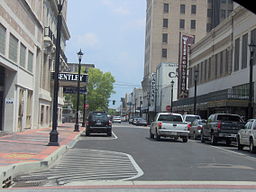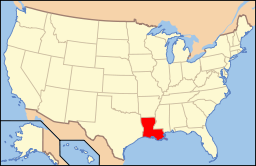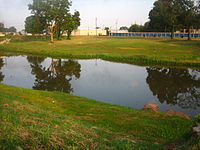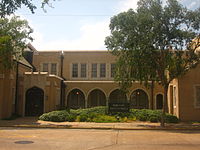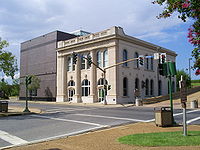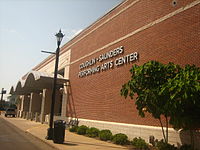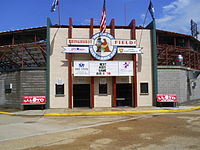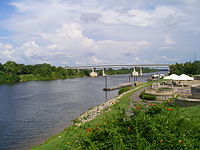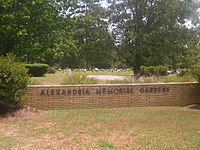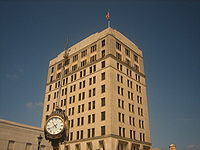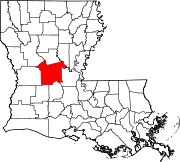- Alexandria, Louisiana
-
City of Alexandria City Third Street in downtown AlexandriaNickname: Fist City Country United States State Louisiana Parish Rapides Elevation 75 ft (22.9 m) Coordinates 31°17′34″N 92°27′33″W / 31.29278°N 92.45917°W Area 27.0 sq mi (69.9 km2) - land 26.4 sq mi (68 km2) - water 0.6 sq mi (2 km2), 2.22% - metro 2,027 sq mi (5,250 km2) Population 47,723 (2010) - metro 153,922 (2010) Density 677.5 / sq mi (261.6 / km2) Incorporated 1818 - City Charter 1882 Mayor Jacques Roy Timezone CST (UTC-6) - summer (DST) CDT (UTC-5) ZIP codes 71301-03, 06–07, 09, 11, 15 Area code 318 Phone Number Prefixes 201, 290, 308, 420, 427, 441–443, 445, 448, 449, 473, 483, 484, 487, 542, 561, 619, 767, 769, 787, 880 Website: http://www.cityofalexandriala.com Alexandria is a city in and the parish seat of Rapides Parish, Louisiana, United States.[1] It lies on the south bank of the Red River in almost the exact geographic center of the state. It is the principal city of the Alexandria metropolitan area (population 153,922) which encompasses all of Rapides and Grant parishes. Its neighboring city is Pineville. In 2010, the population was 47,723, according to an official estimate by the College of Business Population Estimates Program at Louisiana Tech University.
Contents
History
The city of Alexandria, located along the Red River, was originally home to a community supporting activities of the adjacent Spanish outpost of Post du Rapides. The area developed as an assemblage of traders and merchants in the agricultural lands bordering the mostly unsettled areas to the north, and providing a link from the south to the El Camino Real and then larger settlement of Natchitoches.
Alexander Fulton, a businessman from Washington County, near Pittsburgh, Pennsylvania, received a land grant from Spain in 1785, and the first organized settlement was made at some point in the 1790s. In 1805, Fulton and business partner Thomas Harris Maddox laid out the town plan and named the town in Fulton's honor. That same year Fulton was appointed coroner in Rapides Parish by territorial Governor William C.C. Claiborne.[2] Alexandria was incorporated as a town in 1819 and received a city charter in 1832.[3]
The Civil War in Alexandria
In the spring of 1863, Alexandria was occupied by Union forces under the command of Admiral David Dixon Porter and General Nathaniel P. Banks. Porter arrived with his gunboats on May 7. Later in the day Banks reached Alexandria with his cavalry, whose members had marched 25 miles to reach the city. According to the historian John D. Winters of Louisiana Tech University, Porter disliked Banks but nevertheless turned over Alexandria to Banks and then departed to rejoin U.S. Grant at the ongoing siege of Vicksburg, Mississippi. Banks posted guards and declared martial law. Porter left behind the gunboat Lafayette in Alexandria and posted the Pittsburg on the Black River to the northeast.[4]
In 1864, Admiral Porter, back in the area, and General Banks quarreled over possession of Louisiana cotton. Porter seized three hundred bales of Confederate cotton from various warehouses in Alexandria and stamped it "U.S.N. prize", referring to the United States Navy. Porter sent his sailors into the country to search for unginned cotton. After the crop was located, it was brought to Alexandria to be ginned and baled. The sailors also seized molasses and wool. Winters writes that Porter "took all cotton wherever he found it, cotton belonging to the Confederate government, cotton belonging to the 'rebels,' and cotton belonging to 'loyal' citizens."[5]
Winters continues: "Banks was furious with Porter when he learned that the admiral was scouring the interior for cotton. Since he had no authority to stop Porter's speculative activities, Banks could only try to beat him to the remaining cotton. Army wagons were sent out in large numbers to collect the cotton. Thousands of bales were brought in by the troops and stored for future shipment. Jealous of the abundant transportation facilities of the army, unprincipled navy men stole army wagons and teams at night, repainted the wagons, and branded the mules with navy initials, and dove deep in the country in search of cotton. . . . "[6]
The federal army made itself as comfortable as possible during its long stay in Alexandria. Winters writes that "lumber and tools were foraged, and the men busied themselves by building wooden tent floors, benches, and furniture. . . . Alexandria [was enclosed] with a zigzag line of fortifications."[7] While Banks remained in Alexandria in the spring of 1864, Porter was temporarily trapped north of the city because of the low level of the Red River, four feet instead of the needed seven feet to accommodate gunboats.[8]
Confederate citizens as a whole were most fearful of the Union. According to Winters, "most [Confederates] had never before seen a Yankee soldier [and] expected the worse from the invader. . . . 'Some cried, some cursed, some whined; and some overcome with fear, hid themselves in the woods, leaving everything to the tender mercies of the army.' Negroes were responsible for much of the plunder and pillage. Negro camp followers and officers' servants roamed the plantations and small farms without hindrance, bringing in their booty to camps each afternoon. . . . "[9]
On May 13, 1864, when the Union decided to abandon Alexandria, the city was set afire despite General Banks' order to the contrary. Winters reports that "burning and plundering" by two Union corps, who set fire to a store on Front Street. Then "a strong wind spread the flames rapidly from one building to the next."[10] Banks later claimed that the fire "broke out in the attic of one of the buildings on the levee inhabited by either soldiers or refugees."[11] Winters reports that "pandemonium reigned; frightened cows bellowed and charged through the flaming streets; squawking chickens with scorched wings tried to fly out of danger. Hundreds of women, children, and old people ran through the streets, trying to carry a few of their belongings to safety. When the heat became unbearable, they dropped their loads and fled to the levee. Thieves ran from house to house and even along the levee taking whatever they wanted from the shocked people. By noon the most congested parts of town were destroyed. An attempt to blow up a church in the path of the fire only succeeded in helping to spread the flames. . . . "[11]
Alexandria faced the overwhelming task of rebuilding with a year of the war remaining. Prices became exorbitant; butter cost $10 a pound, bacon $5 a pound, flour $3 a pound, and a bushel of meal $10. Many of the helpless lived in the forest without food, shelter, or clothing, subsisting on blackberries. All clothing was homespun, and shoes were mostly made of cloth.[12] While Admiral Porter expressed sympathy for the suffering Alexandria residents, he declared the "burning of Alexandria a fit termination of the unfortunate Red River expedition."[11]
Geography and climate
Alexandria is located at 31°17′34″N 92°27′33″W / 31.29278°N 92.45917°W[13] and has an elevation of 75 feet (22.9 m)[14].
According to the United States Census Bureau, the city has a total area of 27.0 square miles (69.9 km2). 26.4 square miles (68.4 km²) of it is land and 0.6 square miles (1.5 km²) of it (2.15%) is water.
Alexandria is on a level plain in the center of the Louisiana Longleaf Pine forests, in which pine is interspersed with various hardwoods. A number of small bayous, such as Bayou Rapides, Bayou Roberts, and Hynson Bayou, meander throughout the city. In the immediate vicinity of the city, cotton, sugar, alfalfa, and garden vegetables are cultivated. The climate is humid subtropical with some continental influence in the winter. Summers are hot and humid, and winters are mild, with occasional cold snaps. The area receives plentiful rainfall year-round, and snowfalls are rare. Tropical storms and hurricanes do impact Alexandria from time to time, but rarely cause severe damage, unlike areas closer to the coast. In September 2005 Hurricane Rita affected Alexandria and surrounding areas, causing widespread power outages and damaging the roofs of some structures. The most recent hurricane, Gustav, caused widespread flooding, knocked over trees and power lines leading to power outages, and damaged structures. Some low-lying Alexandria neighborhoods experienced substantial flooding from Gustav with several feet of water in houses.
Demographics & Culture
Historical populations Census Pop. %± 1850 672 — 1860 1,461 117.4% 1870 1,218 −16.6% 1880 1,800 47.8% 1890 2,861 58.9% 1900 5,648 97.4% 1910 11,213 98.5% 1920 17,510 56.2% 1930 23,025 31.5% 1940 27,066 17.6% 1950 34,913 29.0% 1960 40,279 15.4% 1970 41,557 3.2% 1980 51,648 24.3% 1990 49,188 −4.8% 2000 46,342 −5.8% 2010 47,723 3.0% U.S. Decennial Census As of the census[15] of 2000, there were 46,342 people, 17,816 households, and 11,722 families residing in the city. The population density was 1,754.6/sq mi(677.5/km²). There were 19,806 housing units at an average density of 749.9 per square mile(289.6/km²). The racial makeup of the city was 54.75% Black or African American, 42.60% White, 0.25% Native American, 1.25% Asian, 0.04% Pacific Islander, 0.23% from other races, and 0.89% from two or more races. 0.98% of the population were Hispanic or Latino of any race.
There were 17,816 households out of which 31.9% had children under the age of 18 living with them, 38.5% were married couples living together, 23.2% had a female householder with no husband present, and 34.2% were non-families. 30.4% of all households were made up of individuals and 12.1% had someone living alone who was 65 years of age or older. The average household size was 2.50 and the average family size was 3.13.
In the city the population was spread out with 28.1% under the age of 18, 9.2% from 18 to 24, 26.2% from 25 to 44, 21.4% from 45 to 64, and 15.1% who were 65 years of age or older. The median age was 36 years. For every 100 females there were 83.5 males. For every 100 females age 18 and over, there were 77.7 males.
The median income for a household in the city was $26,097, and the median income for a family was $31,978. Males had a median income of $29,456 versus $20,154 for females. The per capita income for the city was $16,242. About 23.2% of families and 27.4% of the population were below the poverty line, including 37.7% of those under age 18 and 18.5% of those age 65 or over.
Religion
Like many other Southern cities, the largest single religious denomination in the Alexandria area is Southern Baptist. Large congregations include Emmanuel Baptist Church downtown on Jackson Street and Calvary Baptist off Jackson Street Extension. A significant Roman Catholic population is also present.[16] This is due in part to the large Catholic Acadian French population which resides in and around Alexandria, many from neighboring Avoyelles Parish. Alexandria is the headquarters for the Diocese of Alexandria, Louisiana, which is headed by Bishop Ronald Herzog
Alexandria also has a significant number of Methodists, Episcopalians, Pentecostals, as well as adherents to many other Protestant denominations. Furthermore, Alexandria has a small Jewish community consisting of two synagogues: Gemiluth Chassodim (Reform) and B'nai Israel (Conservative).
Annual cultural events and festivals
Mardi Gras
As Alexandria is at the cusp of Cajun culture's extension to the north, the city recognizes Mardi Gras as an official holiday. The annual Mardi Gras parade – occurring on the Sunday before Mardi Gras – on Texas Avenue is a major cultural festivity in the area. Boasted as a true family oriented event, parade goers can enjoy over 20 New Orleans style floats, high school and college marching bands, as well as appearances by local celebrities. In addition to the main Sunday parade, a children's parade takes place downtown on the Saturday before Mardi Gras and another parade known as the Krewe of Provine Parade occurs on Fat Tuesday itself down Coliseum Boulevard.
Cenlabration
Begun in the late 1980s, Cenlabration [17] was one of the largest festivals in Central Louisiana (Cenla). The name comes from Central Louisiana ("LA") Celebration, and reflects local culture and heritage, as well as serving as a means of celebrating Labor Day as the end of summer.
As many as three stages support a particular type of music, including Cajun and zydeco, blues and jazz, and Country music. In addition there are arts and crafts booths for local artists to sell their wares. In the Children's Village, children can participate in arts and crafts, listen to storytellers, play games with clowns, or watch a play. The festival has plenty of carnival rides available as well. Cenlabration ends with a large fireworks display.
RiverFest
In 2002, representatives of local government, businesses, organizations, and community formed the nonprofit organization River Cities Cultural Alliance, Inc. to promote tourism and the arts through a celebration of Central Louisiana’s diverse cultural heritage. The nonprofit served to organize and put on RiverFest: Heritage and Arts on the Red. More than ten thousand festival-goers attending the event.
RiverFest was held in downtown Alexandria and on the Alexandria and Pineville levees. The festival features the work of visual artists from across the South, food booths exemplifying southern cuisine, a variety of children’s activities, three outdoor stages with a wide range of music, dance, and theatrical performances, and a literary component with readings and panel discussions by Louisiana authors and scholars.
RiverFest was canceled in 2007.
Museums
The Alexandria Museum of Art was founded in 1977 and occupies the historic Rapides Bank Building on the banks of the Red River. The building was built circa 1898 and is listed on the National Historic Register. It opened to the public in March 1998.
The Louisiana History Museum is also located downtown. It showcases the history of all Louisiana, with emphasis on the central portion of the state, Rapides Parish, and Alexandria. Major exhibit areas deal with Native Americans, Louisiana geography, politics, health care, farming, and the impact of war.
Kent Plantation House is also located in Alexandria, built circa 1776 on a Spanish land grant this is at 211 years old the oldest standing structure in Central Louisiana, one of only 2 buildings in the city to survive the burning of 1864 by Union troops fleeing after being defeated at Mansfield. The house has been moved from its origional location but still stands on part of the origional land grant. It is open for tours daily Mon-Sat at 9am, 10am, 11am, 1pm,2pm, 3pm. The tour is always done by costumed docents and includes the house furnished in period peices, some belonging to the origional family, and all 9 outbuildings, including an 18450's sugar mill, blacksmith shop, barn, 2 slave cabins, open hearth kitchen and milk house.
Performing arts
The Coughlin-Saunders Performing Arts Center is located on Third Street across from the Alexandria Daily Town Talk building
The site of the center was donated by The Town Talk newspaper, owned by Gannett Co. Inc. of McLean, Virginia.
A local music festival, Jazz on the River, sponsored by the Arna Bontemps African American Museum, is held each April and features a live jazz concert on the banks of the Red River. The Rapides Symphony's annual fall concert Pops in the Park. The spring and fall seasons are also welcomed with Downtown Rocks, a free outdoor concert series.
The Coughlin-Saunders Performing Arts Center on Third Street serves as the home of the Rapides Symphony Orchestra, which has been performing in Alexandria for nearly forty years. Alexandria is also home to the Red River Chorale, an auditioned community chorus. This group is relatively new, but has already gained a reputation of fine music. The RRC regularly performs with the Rapides Symphony Orchestra.
The Arts Council of Central Louisiana programs a yearly Performing Arts Series in the Coughlin-Saunders Performing Arts Center.
Sports
Alexandria is home to the Alexandria Aces, a summer college league team. The Aces have been champions in various leagues in 1997, 1998, 2006, and 2007. They play their home games at Bringhurst Field.
Alexandria is also home to the Cenla Derby Dames, a roller derby team that operates under the Women's Flat Track Derby Association. They play their home games at the Rapides Parish Coliseum.
Nearby is Bringhurst Golf Course, popularly known as "the nation's oldest par three course." A full-scale renovation was completed in mid-2010. In addition to Bringhurst, named for the late industrialist R.W. Bringhurst, Alexandria is home to four other golf courses: Oak Wing, The Links on the Bayou, at LSUA, and Alexandria Golf and Country Club.
Alexandria once had a minor league ice hockey team, the Alexandria Warthogs. They played their home games at the Rapides Parish Coliseum.
There was also a semi-pro football team, the Louisiana Rapides Rangers, who played their home games at the Rapides Parish Coliseum. They played in the Central District of the Southern American Football League, and the Southern Conference of the National Indoor Football League (NIFL). The team was owned by a Lafayette business group before moving to Beaumont, Texas in 2003.
In 1974, a Little League team from Alexandria won the Louisiana state championship.
Alexandria is also home to the U-14 Crossroads Pride soccer team. They advanced to the 2010 State Cup under the coaching of Craig Harwell.
Notable people
- Morris N. Abrams — educator[18]
- Jay Aldrich — Major League Baseball player
- John Ardoin — music critic for The Dallas Morning News
- Arna Bontemps — African American poet and member of Harlem Renaissance
- W. K. Brown - state representative from Grant and Rapides parishes (1960–1972)
- William F. Cotton — once the oldest living World War I veteran
- Ed Cullen — Baton Rouge Morning Advocate columnist, National Public Radio essayist and author
- Nelder Dawson - newspaper executive
- Virginia deGravelles — Republican national committee member
- Helen Derr - journalist, co-founder of Friendship House of Alexandria[19]
- Sue Eakin – historian, professor, journalist
- Eugene Wilton Frémaux — businessman
- R. W. "Buzzy" Graham - state representative from 1968 to 1972
- Camille F. Gravel, Jr. -- attorney and politician
- Henry E. Hardtner — state legislator
- Lance Harris - incoming state representative from Rapides Parish
- Ralph Waldo Emerson Jones - president of Grambling State University, lived in Alexandria in the middle 1920s.
- Catherine D. Kimball — Chief Justice of the Louisiana Supreme Court
- Gillis William Long — U.S. representative
- Gerald Archie Mangun — Pastor of the largest congregation in the city
- Warren Morris — Major League Baseball player
- Craig Nall— National Football League player
- J. Tinsley Oden — mathematician
- Juan Pierre — Major League Baseball player
- Chris Roy, Jr. - Departing state representative from Rapides and Vernon parishes since 2008
- Jacques Roy - mayor of Alexandria since 2006
- Bill Schroll - National Football League player
- Jock Scott - State legislator, attorney, professor
- William Tecumseh Sherman — First superintendent; Louisiana State Seminary of Learning & Military Academy (later to become LSU)
- Russ Springer — Major League Baseball player (18 years)
- Morgan W. Walker, Sr. — head of the southern division of Continental Trailways
- Little Walter (Marion Walter Jacobs) — blues musician
- Muse Watson — actor
- James Madison Wells — governor of Louisiana
- Joanne Lyles White- humanitarian, philanthropist; founder and first President of the Louisiana Speech League
- Antonio N. Valenzuela - 2 Time National Champion Boxer, 3 Time La. Governors Games Champion, 4 Time Golden Gloves Champion, Silver Gloves Champion
Media
Newspapers
Established March 17, 1883, the Alexandria Daily Town Talk is a daily newspaper serving the Alexandria-Pineville communities, as well as the 13 parishes that comprise central Louisiana. The newspaper was owned by the family of Jane Wilson Smith and Joe D. Smith Jr., until March 1996, when it was sold to Central Newspapers. In August, 2000, Gannett Co. Inc. acquired the Central Newspapers properties including The Town Talk. The name of the paper on its inaugural issue was the Alexandria Daily Town Talk. Although it has since been shorted to the current the Town Talk, it is still frequently referred to by long-time residents as the Daily Town Talk.
Key officers include: Publisher William "Ed" Humphrey; Executive Editor Paul V. Carty; Advertising Director William "Bill" Heirtzler; and Assistant Managing Editors John Marcase and Richard Powell Sharkey.
Television
Alexandria is served by local television stations KALB (NBC), WNTZ (Fox), KLAX (ABC), KLPA (PBS), and KBCA (The CW). KALB, the oldest television station in central Louisiana, has signed an affiliation deal with CBS, and has begun carrying CBS programming on digital channel 5.2 / 35.2. Before then, central Louisiana viewers watched CBS on KLFY-TV (out of Lafayette), WAFB-TV (out of Baton Rouge) or KNOE-TV (based in Monroe, before a tower collapse in March 1997).
Radio
Local radio stations
- KJMJ 580 AM - Religious
- KSYL 970AM - News / Talk / Sports
- KDBS 1410AM - ESPN Radio
- KLXA 89.9FM - Contemporary Christian
- KRRV 100.3FM - Country
- KKST 98.7FM - Hip Hop & R&B
- KQID 93.1FM - Top 40
- KZMZ 96.9FM - Classic Rock
- KLAA 103.5FM - Louisiana Country
- KEZP 104.3 - News / Talk / Sports
- KBKK 105.5 - Classic Country
- KEDG 106.9FM - 1980s, 1990s, and Now
Parks and outdoor attractions
Alexandria Zoological Park
Main article: Alexandria Zoological ParkThe Alexandria Zoological Park is a 33-acre (13 ha) zoo first opened to the public in 1926. Owned by the City of Alexandria and operated by the Division of Public Works, it is home to about 500 animals and includes an award-winning Louisiana Habitat exhibit. Much of the credit for the quality of the zoo has been given to Robert Leslie Whitt (1951–2008), who served as director for 34 years prior to his death. Whitt was hired in 1974 by then Streets and Parks Commissioner Malcolm P. Hebert, Sr. The zoo is accredited by the Association of Zoos and Aquariums (AZA) and takes part in about 20 Species Survival Plans (SSP) as part of its conservation efforts.
Cotile Lake Recreation Area
Cotile Lake is a man-made impoundment located in the uplands approximately 15 miles (24 km) west-northwest of Alexandria, Louisiana. The lake is approximately 1,775 acres (7 km2) in size and was completed in October 1965. The Louisiana Wild Life and Fisheries Commission stocked this impoundment with the proper species and number of game fish in 1965–66 shortly after its completion date. The recreational facilities include a large area cleared and zoned for swimming with complete bath house facilities nearby. There is a water skiing area that is cleared and snagged for safety of the skiers. The picnic and camping areas are modern and complete. There is also space available for campers.
Indian Creek Lake and Recreation Area
Encompasses a 2,250-acre (9 km2) lake, 100 acres (0.4 km2) of developed recreation facilities and a 250 acres (1.0 km2) primitive camping area all within the Alexander State Forest. The lake, located in central Louisiana, was constructed as a joint venture of the Louisiana Forestry Commission, the Rapides Parish Police Jury, and the Lower West Red River Soil and Water Conservation District as a reservoir for agricultural irrigation in times of need and for recreation purposes.
The recreation area camping area contains 109 campsites with conventional full utility hookups, 3 beaches for swimming, bath houses, a boat launch, and 75 picnic sites. A covered pavilion within the developed area provides for groups up to 100 people. The recreation area is open year round and operates on user fees.
Kisatchie National Forest
Alexandria sits in the middle of the Kisatchie National Forest. Ranger districts are north, northwest, west and southwest of the city. An abundance of large timberlands and forest nurseries, as well as lake and recreation areas, are within a short driving distance.
Other points of interest
- Alexandria Memorial Gardens – large cemetery on U.S. Highway 165 south. Other cemeteries are also available in Pineville.
- Alexandria Levee Park – a park located downtown, adjacent to the Red River, that serves as the grounds for some local festivals. It contains an amphitheatre that is used for concerts.
- Alexandria Mall – the local shopping mall located on Masonic Drive, established 1973
- Alexandria Riverfront Center – convention center located downtown
- Bringhurst Field – home of the Alexandria Aces
- Bringhurst Park – contains the Alexandria Zoo, Bringhurst Field, a playground, a golf course, and tennis courts
- Inglewood Plantation – plantation located south of Alexandria
- Kent Plantation House – French colonial plantation house
- Masonic Home – a now defunct orphanage in south Alexandria completed in 1924.
- Rapides Parish Coliseum – a multi-purpose arena used for sporting events, conventions, and other events
Military
Louisiana National Guard
Alexandria is home to both Headquarters and Company B of the 199th Brigade Support Battalion (BSB). The 199th BSB is the logistical component of the 256th Infantry Brigade that served in Operation Iraqi Freedom from October 2004 until September 2005. The 199th BSB provides supply and transportation (Company A), medical (Company C) and maintenance (Company B) support and services that keep the 256th Brigade operational. The battalion also has units located in Jonesboro, Winnfield, Colfax, and St. Martinville, Louisiana.
England Air Force Base
Alexandria served as the home of England Air Force Base from its origins as an emergency airstrip for Esler Regional Airport until its closure. England AFB was officially closed on December 15, 1992, pursuant to the Defense Base Closure and Realignment Act (Public Law 101-510) and recommendations of the Defense Secretary's Commission on Base Realignment and Closure.[20] The base now serves as Alexandria International Airport.
Economy
At the time of the 2000 census, the per capita income in Alexandria was $16,242, compared with $21,587 nationally. The Alexandria workforce consists of about 55,000 residents.[21] Union Tank Car Company has recently located a plant northwest of Alexandria near the airport creating hundreds of jobs. Expansions at the Procter & Gamble plant and the construction of a PlastiPak plant in nearby Pineville have also created a number of new jobs for the area.
In 2007, Inc. Magazine rated Alexandria as the 77th best place in which to conduct business out of the 393 U.S. cities ranked, a significant increase from its ranking as No. 276 in 2006. Among other Louisiana cities, Alexandria ranked second, following only Baton Rouge, which ranked 59th nationally.[22]
Healthcare
Alexandria is home to two major hospitals: Rapides Regional, a former Baptist hospital is located downtown. Christus St. Frances Cabrini Hospital was opened in 1950 and is located at the corner of Masonic Drive and Texas Avenue. Both hospitals are in the process of expansion.
Additionally, located just across the Red River in Pineville, the Veteran's Affairs Medical Center at Alexandria, which serves central Louisiana and surrounding areas.
Port of Alexandria
In the early 19th century, the Port of Alexandria brought goods to the area and shipped cotton and other local products to the rest of the country. A ferry connected the cities of Alexandria and Pineville until a bridge was built across the Red in 1900.
Today, Port facilities include: a 40-ton crane for off-loading, a 15,000-square-foot (1,400 m2) warehouse, 13,600-ton bulk fertilizer warehouse, a 3,400-ton bulk fertilizer dome structure and a 5,000-ton dome which was added in January 2005.
The petroleum off-loading facility includes two 55,000 bbl (8,700 m3) tanks, one 15,000 bbl (2,400 m3) tank capable of handling two barges and five truck off-loading simultaneously. There is also a general cargo dock with access to rail and a hopper barge unloading dock with conveyor system.
Today's modern facilities and the Port's central location with its connection to the Mississippi River provide excellent opportunities for importers and exporters.
Alexandria International Airport
Alexandria International Airport (AEX) is a regional airport, providing flights to Atlanta, Dallas/Ft. Worth, Houston, and Memphis.[23] In 2006 a new-state-of-the-art passenger terminal was dedicated. Alexandria is served by American, Continental and Delta. Additionally, numerous international charter airlines use the airport in the transport of military personnel attached to the United States Army base at Fort Polk. A new military personnel terminal opened in 2007.
Neighborhoods
Downtown
Downtown Alexandria is currently in the process of revitalization. During the past five years, several bars, cafes, and restaurants have opened their doors, including the casual fine dining restaurant Diamond Grill, located in the renovated Schnack's Building; Finnegan's Wake, an Irish pub with nin imports/microbrews on tap; and Alex 1805, a jazz lounge featuring local art and live music. Across the street is the Hotel Bentley, built in 1908 by lumberman and local eccentric Joseph A. Bentley. The Bentley enjoyed its heyday during the 1940s and 50s, when top brass military officials like General Dwight D. Eisenhower enjoyed their accommodations for extended periods. The Bentley, which was closed on December 12, 2004, was once one of only two four-star hotels in Louisiana. Although the hotel was set to reopen in August 2007, in time for the 100th anniversary of its construction, funding issues have made the date of reopening uncertain.
Central Alexandria
Central Alexandria is bounded by MacArthur Drive, Masonic Drive, Mason Street, the Alexandria-Pineville Expressway, and the Red River.
- Downtown
- West End
- Garden District – contains many large historical homes and brick roads. Many of the homes in this neighborhood have been renovated and come in many architectural styles. Houses range from modest bungalows to mansions.
- Poplar Grove
- Hillcrest
- Kent Addition
- Petrus Heights
- Mimosa Place
- Shirley Park
- City Park area – location of Bringhurst Field and Alexandria Zoological Park
Northwestern Alexandria
Northwestern Alexandria comprises the area north of Louisiana Highway 28 West and MacArthur Drive and south of the Red River.
- Sycamore Place
- Wooddale Park – large public housing development
- North Park Village
- Kellyland - largely African-American impoverished neighborhood
- Walnut Grove
- England Airpark
- Rue Left Bank
- Bonaire
- Grundy Cooper – older middle class subdivision behind the Rapides Parish Coliseum
- Cloverdale
- Westwind
- St. Andrew's Links Estates – a subdivision being developed around the golf course Links on the Bayou
Western Alexandria
Western Alexandria is the area south of Highway 28 West, west of MacArthur Drive, and north of Versailles Boulevard and Metro Drive
- The Lakes District – subdivision under development that contains small lakes and long walking trails and is bounded by a nature preserve
- Briarwood
- L. E. Deselle
- Castle Village
- Wilshire Park
- Charles Park – large development of upscale homes primarily built from the late 1960s to the early 1980s
- Hunter's Grove
- Highpoint
- The Centre – commercial development between Jackson Street and MacArthur that contains numerous businesses. A five-story office building was built in the late 1970s which now houses Red River Bank. An 87.5-foot (30 m) tall, six-story high-rise houses Regions Bank and private executive offices.
Southwestern Alexandria
Southwestern Alexandria comprises the area west of Masonic Drive and south of Versailles Boulevard and Metro Drive.
- Plantation Acres
- Clermont Estates
- Fairfield
- Good Earth – large middle class development built in late 1970s and early 1980s
- Lebanon
- Cherokee Village – tree-shaded neighborhood of large older homes
- Four Leaf Village
- West Pointe on the Bayou – large upper-middle class neighborhood under development since the early 1990s, adjacent to Bayou Roberts
- Bocage
- Crossgates – gated community of patio homes
- Landmark – one of Alexandria's most affluent subdivisions
- Tennyson Oaks – an upper class neighborhood being developed next to Landmark adjacent to Bayou Roberts
Southern Alexandria
Southern Alexandria is located east of Masonic Drive and south of MacArthur Drive
- Courtland Place
- Bayou Robert – affluent cul-de-sac bordered by Bayou Robert
- Shenandoah
- Horseshoe Gardens
- Deerfield – middle class development built in 1970s
- Martin Park – combination of middle to upper-class houses built from the 1960s to 1970s. Lisa Street connects the Martin Park and Airview Terrace neighborhoods.
- Collins Estates
- Airview Terrace
- Trail Ridge
- Willow Glen
- Ransville
Southeastern Alexandria
Southeastern Alexandria contains the area northeast of MacArthur Drive, south of Masonic Drive, Mason Street, and Alexandria-Pineville Expressway, and bordered by the Red River.
- Alexandria Mall area – retail center of Alexandria
- Southwood Terrance - small community of middle and upper class African Americans
- Wedgewood Downs
- Bacon Place
- Sonia Quarters – large working class neighborhood containing many shotgun-style homes
- Samtown – largely African-American impoverished neighborhood
- Woodside
- Parkway
- Lower Third
- Riverbend
- Acadian Village - large community of middle class African Americans
- Alsace Lorraine
Surrounding cities and towns
Rapides Parish
Grant Parish
Government and politics
Local government
History
Following the Civil War, all public records in Alexandria had been destroyed. On September 29, 1868, the city was granted a new charter with a government consisting of a Mayor, Treasurer, and Justice of the Peace. Nine aldermen represented the four wards of the city – two from each ward and one elected at-large.
In 1912, the Lawrason Act established Alexandria municipal government in a strong mayor format, where the mayor was also the Commissioner of Public Health and Safety (Police, Fire, Sanitation). There were separate Commissioners of Streets and Parks and Finance and Utilities, elected citywide. The last to hold those positions, which ended in 1977, were Mayor John K. Snyder (1922–1993), Malcolm P. Hebert, Sr. (1926–2006), and Arnold Jack Rosenthal (1923–2010), respectively.
Today
Alexandria has a mayoral-council system of government. The Mayor serves as the executive branch of the local government. The current Mayor – Jacques Roy – was elected to office in November 2006, succeeding long-time mayor Edward Gordon "Ned" Randolph, Jr. Randolph had succeeded John K. Snyder.[24]
The City Council serves as the legislative branch. The five districts of the city are represented on the Council; in addition there are two council members elected to serve as at-large representatives of the city.
The Alexandria Court has a limited jurisdiction, consisting of the citizens of Wards 1, 2 and 8 in Rapides Parish. Within those boundaries the court has the power to hear and decide both criminal and civil cases, rule in civil cases and hand down judgment for punishment in criminal cases.
Area politics
Overall, the people of the Alexandria area tend to be conservative. Even though the majority typically elects Republicans in national elections, they vote for Democrats in local elections, many of which are not contested by the GOP[citation needed].
United States Congressional district
From 1913 to 1993, Alexandria served as the seat of Louisiana's Eighth Congressional district. A Democratic seat, it was held by the Long family for nearly half of its existence, from 1953 to 1987, broken only by the two terms of Harold B. McSween and three terms of Republican Clyde Holloway of Forest Hill. The seat was removed after the 1990 census indicated Louisiana no longer had the population to support it. The district was split among the Fourth, Fifth and Sixth Congressional districts. Alexandria is now in the Fifth district and has been represented since 2003 by Rodney Alexander, a Democrat-turned-Republican.
Education
Colleges and universities
Situated south of the city, Louisiana State University at Alexandria (or LSUA) is a regional campus of the state's flagship university system, Louisiana State University. From its establishment in 1959, the campus offered only two-year degrees; students seeking baccalaureate degrees had to commute or move to the main campus in Baton Rouge in order to gain a four-year degree. After 1976, students could either commute or telecommute in order to attend upper level courses, including graduate classes. In 2002, following approval by the Louisiana State University Board of Supervisors and the Louisiana Board of Regents the Louisiana Legislature passed legislation allowing LSUA to offer baccalaureate degrees.
A four-year degree is also attainable through Southern Baptist-affiliated Louisiana College in Pineville, founded in 1906.
Alexandria also has one of the Region 6 Louisiana Technical College campuses.
High schools
Alexandria has three public high schools: Bolton High School, Alexandria Senior High School, and Peabody Magnet High School. In addition, there are two private high schools: the Roman Catholic Holy Savior Menard Central High School, and Grace Christian.
The Renaissance Home for Youth west of Alexandria is a haven for youthful offenders who live in a group-home setting as an alternative to reform school or adult jail. Since the facility opened in 1973, nearly 12 thousand young people have lived at the home in search of rehabilitation.[25]
Transportation
Roads
Alexandria serves as the crossroads of Louisiana. To reach either Shreveport or Monroe from the southern portion of the state, the easiest method of travel takes the driver through Alexandria. Likewise, if a visitor is to head from the northern portion of the state to the Cajun portions of the state (Lake Charles and Lafayette), or the greater metropolitan areas of either Baton Rouge or New Orleans, the easiest method of travel involves driving down Interstate 49 through Alexandria.
In addition to I-49, travelers can follow Louisiana 1 up to Alexandria from Baton Rouge and points south. Also, Highway 167 could be taken from Opelousas north to Monroe, crossing through Alexandria at one of the few bridges over the Red River in central Louisiana. Highways 165 and 71 also link Alexandria and points south with the northern portion of the state via the OK Allen bridge.
Bridges
Three road bridges cross the Red River in the Alexandria area. They are:
- The Purple Heart Memorial Bridge. Part of the Alexandria-Pineville Expressway (also referred to as the Cottingham Expressway), it connects Interstate 49 to Highway 167 by crossing the Red River from downtown Alexandria to Pineville. It replaced the Fulton Street Bridge and has six lanes of traffic. Designed by the Louisiana Department of Transportation and Development (LADOTD), the bridge cost $15.9 million in federal and state funds. The northbound portion was completed in 1995, the southbound in 1998.
- The U.S. 165 Business Bridge (alternatively, the Gillis Long Bridge, the Red River Bridge or the Jackson Street Bridge) connecting downtown Pineville with the business district in Alexandria. It is a two-lane vertical-lift bridge with a sidewalk/bikepath on either side. The bridge is named after U.S. Representative Gillis Long, who represented Louisiana's Eighth Congressional District. It was built in 1985 to replace the Murray Street Bridge.
- The Oscar K. Allen Bridge connecting Highway 165/71 on both sides of the Red River. It is a two-lane K-truss type bridge, named after Governor Oscar K. Allen. It was built in 1936 to connect Alexandria to the (former) Fort Buhlow.
Former bridges include:
- The Murray Street Bridge. One of the first bridges in Alexandria. A two-lane steel truss swing bridge, it decayed over time, finally being demolished in 1983. The approach on the Alexandria side was turned into a river overlook as part of the Alexandria Levee Park.
- The Fulton Street Bridge. Named after Fulton Street which it connected with Highway 167. Technically part of the Alexandria-Pineville Expressway, it was a four-lane steel vertical-lift bridge. It was demolished in 1994 to make way for the Purple Heart Memorial Bridge.
There are two railroad bridges over the Red River in Alexandria. One is located near the Buhlow area north of the OK Allen bridge. The other is south of the Purple Heart Memorial Bridge.
Mass transit
Regional mass transit is handled by ATRANS (Alexandria Transportation Authority).
For those leaving or arriving at the city by bus, Greyhound Lines has a terminal downtown.
Airports
Alexandria is served by the Alexandria International Airport and the Esler Regional Airport in Pineville.
Rail
Alexandria does not have a commuter rail system. The Kansas City Southern and the Missouri Pacific operated train stations in the area in the early part of the 20th century but these have since closed.
Gallery
-
Scenic view of Red River taken from levee in Alexandria
-
Former Missouri Pacific Railroad depot in downtown Alexandria historic district
References
- ^ "Find a County". National Association of Counties. http://www.naco.org/Counties/Pages/FindACounty.aspx. Retrieved 2011-06-07.
- ^ "Fulton, Alexander". lahistory.org (Louisiana Historical Association). http://www.lahistory.org/site23.php. Retrieved October 9, 2010.
- ^ Community
- ^ John D. Winters, The Civil War in Louisiana, Baton Rouge: Louisiana State University Press, 1963, ISBN 0-8071-0834-0, p. 235
- ^ Winters, p. 331
- ^ Winters, pp. 331-332
- ^ Winters, pp. 366-367
- ^ Winters, pp. 367-369
- ^ Winters, p. 236
- ^ Winters, pp. 373-374
- ^ a b c Winters, p. 374
- ^ Winters, pp. 386-387
- ^ "US Gazetteer files: 2010, 2000, and 1990". United States Census Bureau. 2011-02-12. http://www.census.gov/geo/www/gazetteer/gazette.html. Retrieved 2011-04-23.
- ^ "US Board on Geographic Names". United States Geological Survey. 2007-10-25. http://geonames.usgs.gov. Retrieved 2008-01-31.
- ^ "American FactFinder". United States Census Bureau. http://factfinder.census.gov. Retrieved 2008-01-31.
- ^ The Association of Religion Data Archives | Maps & Reports
- ^ "Alexandria Pineville Area Convention & Visitors Bureau" (notes), webpage: LAfromhere-pparty.
- ^ "Abrams, Morris Newton". Louisiana Historical Association, A Dictionary of Louisiana Biography (lahistory.org). http://www.lahistory.org/site18.php. Retrieved December 24, 2010.
- ^ "Helen Elizabeth Derr". Alexandria Daily Town Talk, June 24, 2011. http://www.legacy.com/obituaries/thetowntalk/obituary.aspx?n=helen-elizabeth-derr&pid=152177961&fhid=12059. Retrieved June 26, 2011.
- ^ England Industrial Airpark
- ^ Alexandria, Louisiana LA, city profile (Rapides Parish) – hotels, festivals, genealogy, newspapers – ePodunk
- ^ Small Business Resources for the Entrepreneur from Inc.com
- ^ http://www.ifly.com/alexandria-international-airport
- ^ Louisiana Secretary of State Official Parish Election Results for Election Date: 11/07/06
- ^ "Renaissance: Our History". renaissancehome.org. http://renaissancehome.org/history/. Retrieved March 25, 2010.
External links
- City of Alexandria : Government and community services.
- The Town Talk : Alexandria's Local Daily Newspaper.
- KALB-TV : Alexandria's Local NBC Station.
- KLAX-TV : Alexandria's Local ABC Station.
- Visit Alexandria : Business Directory.
- The Alexandria Retrospective : Alexandria photos, postcards, history, artifacts.
- The Historic Bentley : Memories of the elegant past of the Hotel Bentley: history, artifacts, photographs, postcards.
- Louisiana Nursery Festival
- River Fest
Municipalities and communities of Rapides Parish, Louisiana Cities Alexandria | Pineville
Towns Villages CDP Unincorporated
communitiesCategories:- Alexandria, Louisiana
- Cities in Louisiana
- Populated places in Rapides Parish, Louisiana
- Populated places in Louisiana with African American majority populations
- Parish seats in Louisiana
- Populated places established in 1785
- Alexandria, Louisiana metropolitan area
Wikimedia Foundation. 2010.

